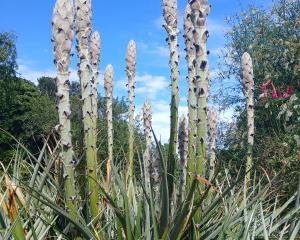Hedges have plenty of appeal, Gillian Vine says.
They can't be scribbled on by graffiti artists, don't need painting, are excellent for shelter (and don't blow over in gales), prickly ones can help deter burglars, they look better than concrete blocks - and are a greener alternative.
What's not to like about a hedge? The main drawback is the need to mulch or fertilise it annually, and trim it twice a year, something that can actually be quite therapeutic as long as you take care if using electric clippers.
Hedges can be formal, where every line is perfectly straight and each stray twig trimmed as soon as it appears, or informal.
The formal hedge is usually evergreen, with yew being the traditional European choice.
Its small leaves give an added advantage, as they look better after trimming than the chopped remnants of large leaves like laurel. Holly and pittosporum come somewhere between the two and, like barbary (Berberis), holly can be used on a boundary to help deter burglars.
The most structured are the little hedges used as edging and in knot gardens. When well maintained they look splendid but there is a lot of work to keep them at their peak year-round, especially as Buxus and Lonicera are prone to blight. Native Lophomyrtus bullata is an attractive alternative.
With informal hedges, plants do their own thing in a more casual way. They can be as simple as a row of roses (rugosas are good for this) used to divide two flowerbeds, or climbers like wisteria or clematis trained along wires. Although overall they require less work, just because they are informal does not mean total neglect is possible.
Native trees and shrubs are being increasingly used for hedging. Top choices are totara, coprosma, corokia and hebe. Most coprosmas are tolerant of a range of conditions but on windy or coastal sites corokia may perform better.
New Zealand broadleaf (Griselinia littoralis) has become popular as a hedge but has some drawbacks.
Being mid-sized, its leaves tend to look ragged after cutting but more serious is its tendency to die in drought situations, as many Auckland gardeners found out last summer.
Leaf blight and die-back can also be a problem and because hard cutting exposes unsightly bare branches, over time broadleaf hedges can become very wide.
For those who want lots of colour, camellias, usually the sasanquas, are popular. They have the advantage of glossy foliage all year round but need cool roots and are best in semi-shaded positions.
In full sun, japonica or forsythia are spring-flowering hedging options. They are also good where space for flowers is limited, as the blossom of both these hardy plants can be picked for the vase.
Other colours come from leaves. Silver germander (Teucrium fruticans) is a fast-growing grey-leafed species; cultivars of corokia, hebe and coprosma have good colour options and native golden totara is an alternative to the green form.
Fruit trees are useful hedges for small gardens: apples, pears, quinces, feijoas plus plums and other stone fruits can be espaliered; currants and gooseberries can make an informal hedge to hide compost bins or other utilitarian features, while blueberries and New Zealand cranberries (Ugni molinae) are excellent lower-growing plants for edging a vegetable plot.
Pleaching, sometimes called ''hedges on stilts'', is an ancient practice that involves growing a hedge with the lower part of the trunks left bare. Pleaching lets in more light and makes it possible to grow other plants underneath the hedge.
Finally comes the ''no trim'' hedge. Dead hedging is another old European technique where a double row of posts has flexible material like tree trimmings woven around them before the centre is filled with twigs and leaves which are left to break down. It doesn't look elegant but if all else fails, it's worth considering.












